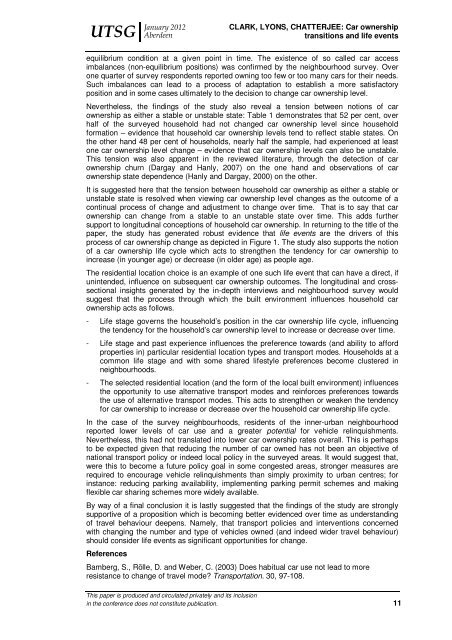Clark, B., Lyons, G. and Chatterjee, K. (2012) - UWE Research ...
Clark, B., Lyons, G. and Chatterjee, K. (2012) - UWE Research ...
Clark, B., Lyons, G. and Chatterjee, K. (2012) - UWE Research ...
Create successful ePaper yourself
Turn your PDF publications into a flip-book with our unique Google optimized e-Paper software.
UTSG<br />
January <strong>2012</strong><br />
Aberdeen<br />
CLARK, LYONS, CHATTERJEE: Car ownership<br />
transitions <strong>and</strong> life events<br />
equilibrium condition at a given point in time. The existence of so called car access<br />
imbalances (non-equilibrium positions) was confirmed by the neighbourhood survey. Over<br />
one quarter of survey respondents reported owning too few or too many cars for their needs.<br />
Such imbalances can lead to a process of adaptation to establish a more satisfactory<br />
position <strong>and</strong> in some cases ultimately to the decision to change car ownership level.<br />
Nevertheless, the findings of the study also reveal a tension between notions of car<br />
ownership as either a stable or unstable state: Table 1 demonstrates that 52 per cent, over<br />
half of the surveyed household had not changed car ownership level since household<br />
formation – evidence that household car ownership levels tend to reflect stable states. On<br />
the other h<strong>and</strong> 48 per cent of households, nearly half the sample, had experienced at least<br />
one car ownership level change – evidence that car ownership levels can also be unstable.<br />
This tension was also apparent in the reviewed literature, through the detection of car<br />
ownership churn (Dargay <strong>and</strong> Hanly, 2007) on the one h<strong>and</strong> <strong>and</strong> observations of car<br />
ownership state dependence (Hanly <strong>and</strong> Dargay, 2000) on the other.<br />
It is suggested here that the tension between household car ownership as either a stable or<br />
unstable state is resolved when viewing car ownership level changes as the outcome of a<br />
continual process of change <strong>and</strong> adjustment to change over time. That is to say that car<br />
ownership can change from a stable to an unstable state over time. This adds further<br />
support to longitudinal conceptions of household car ownership. In returning to the title of the<br />
paper, the study has generated robust evidence that life events are the drivers of this<br />
process of car ownership change as depicted in Figure 1. The study also supports the notion<br />
of a car ownership life cycle which acts to strengthen the tendency for car ownership to<br />
increase (in younger age) or decrease (in older age) as people age.<br />
The residential location choice is an example of one such life event that can have a direct, if<br />
unintended, influence on subsequent car ownership outcomes. The longitudinal <strong>and</strong> crosssectional<br />
insights generated by the in-depth interviews <strong>and</strong> neighbourhood survey would<br />
suggest that the process through which the built environment influences household car<br />
ownership acts as follows.<br />
- Life stage governs the household’s position in the car ownership life cycle, influencing<br />
the tendency for the household’s car ownership level to increase or decrease over time.<br />
- Life stage <strong>and</strong> past experience influences the preference towards (<strong>and</strong> ability to afford<br />
properties in) particular residential location types <strong>and</strong> transport modes. Households at a<br />
common life stage <strong>and</strong> with some shared lifestyle preferences become clustered in<br />
neighbourhoods.<br />
- The selected residential location (<strong>and</strong> the form of the local built environment) influences<br />
the opportunity to use alternative transport modes <strong>and</strong> reinforces preferences towards<br />
the use of alternative transport modes. This acts to strengthen or weaken the tendency<br />
for car ownership to increase or decrease over the household car ownership life cycle.<br />
In the case of the survey neighbourhoods, residents of the inner-urban neighbourhood<br />
reported lower levels of car use <strong>and</strong> a greater potential for vehicle relinquishments.<br />
Nevertheless, this had not translated into lower car ownership rates overall. This is perhaps<br />
to be expected given that reducing the number of car owned has not been an objective of<br />
national transport policy or indeed local policy in the surveyed areas. It would suggest that,<br />
were this to become a future policy goal in some congested areas, stronger measures are<br />
required to encourage vehicle relinquishments than simply proximity to urban centres; for<br />
instance: reducing parking availability, implementing parking permit schemes <strong>and</strong> making<br />
flexible car sharing schemes more widely available.<br />
By way of a final conclusion it is lastly suggested that the findings of the study are strongly<br />
supportive of a proposition which is becoming better evidenced over time as underst<strong>and</strong>ing<br />
of travel behaviour deepens. Namely, that transport policies <strong>and</strong> interventions concerned<br />
with changing the number <strong>and</strong> type of vehicles owned (<strong>and</strong> indeed wider travel behaviour)<br />
should consider life events as significant opportunities for change.<br />
References<br />
Bamberg, S., Rölle, D. <strong>and</strong> Weber, C. (2003) Does habitual car use not lead to more<br />
resistance to change of travel mode? Transportation. 30, 97-108.<br />
This paper is produced <strong>and</strong> circulated privately <strong>and</strong> its inclusion<br />
in the conference does not constitute publication. 11

















